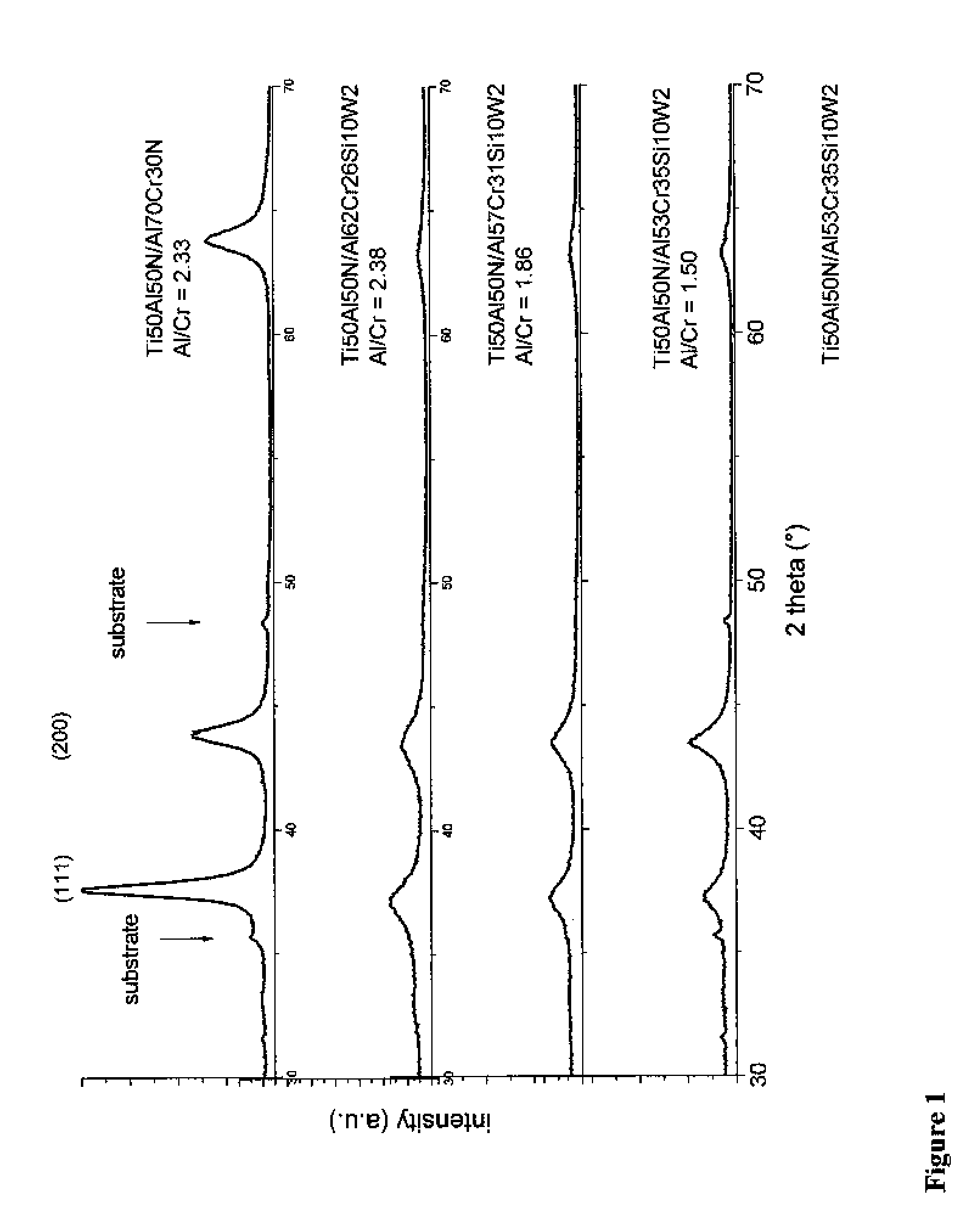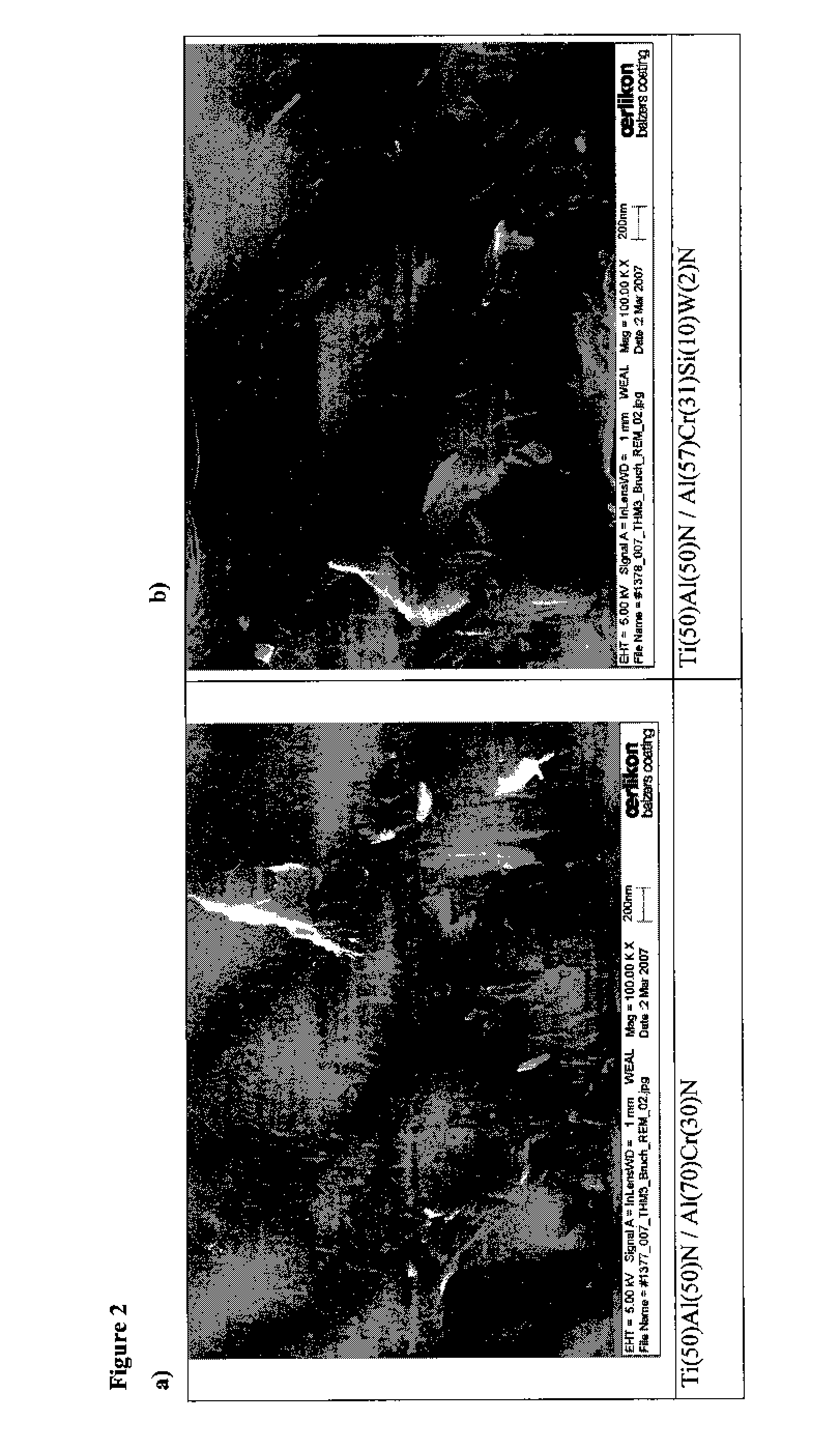Wear resistant hard coating for a workpiece and method for producing the same
a technology of hard coating and workpiece, which is applied in the field of wear resistant hard coating for workpieces and the production of the same, can solve the problems of not significantly improving the tooling performance of materials, and achieve the effect of improving cutting performance and good potential
- Summary
- Abstract
- Description
- Claims
- Application Information
AI Technical Summary
Benefits of technology
Problems solved by technology
Method used
Image
Examples
example 1
[0045]With example 1 cutting performance of endmills coated with state of the art coatings like TiAlN, AlTiN, AlCrN and (AlCrSiW)N has been compared to a serial of inventive endmills coated with TiAlN or AlCrN / (Al1-c-d-eCrcSidWe)N double layered coatings.
[0046]All coatings have been synthesized by cathodic arc evaporation. Deposition of coatings No 1.4 to No 1.10 has been conducted at a deposition temperature of 600° C. and a total pressure of 3.5 Pa under nitrogen atmosphere. For the first support layer a low bias voltage preferably between −40 V and −100 V has been applied while for the second layer a higher bias voltage of −80 V to −200V has been used, whereas absolute value of bias voltage of the second layer was at least 20 V, preferably 40 V higher than bias voltage of the first layer. Deposition of coatings No 1.1 to No 1.3 has been conducted at a deposition temperature of 500° C. and a total pressure of 3.0 to 4.0 Pa under nitrogen atmosphere.
[0047]Data with reference to com...
example 2
[0050]With example 2 the same deposition parameters were applied as with example 1.
[0051]With experiments 2.1 to 2.3 Si content of the second coating is varied at a constant Al / Cr ratio, with experiments 2.4 to 2.6 ratio of Al / Cr is varied at constant Si content. Only small variations of tungsten—around 2±0.3% to the maximum—were measured for all experiments of example 2, as displayed in table 2.
Milling Conditions:
[0052]
Work piece:DIN 1.2379 (60 HRC)Cutting tool:2-fluted ball nose end-mill, Ø 10 mm, micro graincarbide gradeSpindle rotation:8000 min − 1Cutting speed:200 mmin − 1Feed rate:0.1 mm / toothRadial depth of cut:0.5 mmAxial depth of cut:0.3 mmCoolant:compressed dry airMilling operation:down millingLength of single pass:30 mEnd of lifetime:vbmax > 100 um at the end a single pass
[0053]In table 2, at constant Si content (No. 2.4-2.6) hardness measurements show a decrease of hardness with increasing Al / Cr-content of the second coating. At constant Al / Cr-ratio a maximum of the hard...
example 3
[0055]Milling capacity of innovative coating No 3.4 has been compared to state of the art coatings No 3.1-3.3 during a roughing operation according to the parameters mentioned below. With example 3 the same referring deposition parameters were applied as mentioned with example 1.
Milling Conditions:
[0056]
Work piece:DIN 1.2344 (52 HRC)Cutting tool:2-fluted ball nose end-mill, Ø 10 mm, micro graincarbide gradeSpindle rotation:4690 min−1Cutting speed:80 mmin−1Feed rate:0.15 mm / toothRadial depth of cut:4 mmAxial depth of cut:0.8 mmCoolant:compressed dry airMilling operation:down millingLength of single pass:15.5 mEnd of lifetime:vbmax > 150 um at the end a single pass
[0057]
TABLE 3targetcompositionsupporttarget compostioncuttinglayer s.l.main layerthicknessperformance(% at)m.l. (% at)ratiolifetime atNo.coatingAlCrTiAlCrTiSiWm.l. / s.l.vb = 200 um (m)3.1TiAlN———50—50———933.2AlTiN———66—33———1623.3AlCrN———7030————181.53.4TiAlN / AlCrSiWN50—505731—1021.84264
PUM
| Property | Measurement | Unit |
|---|---|---|
| thickness | aaaaa | aaaaa |
| Rockwell hardness | aaaaa | aaaaa |
| temperature | aaaaa | aaaaa |
Abstract
Description
Claims
Application Information
 Login to View More
Login to View More - R&D
- Intellectual Property
- Life Sciences
- Materials
- Tech Scout
- Unparalleled Data Quality
- Higher Quality Content
- 60% Fewer Hallucinations
Browse by: Latest US Patents, China's latest patents, Technical Efficacy Thesaurus, Application Domain, Technology Topic, Popular Technical Reports.
© 2025 PatSnap. All rights reserved.Legal|Privacy policy|Modern Slavery Act Transparency Statement|Sitemap|About US| Contact US: help@patsnap.com



